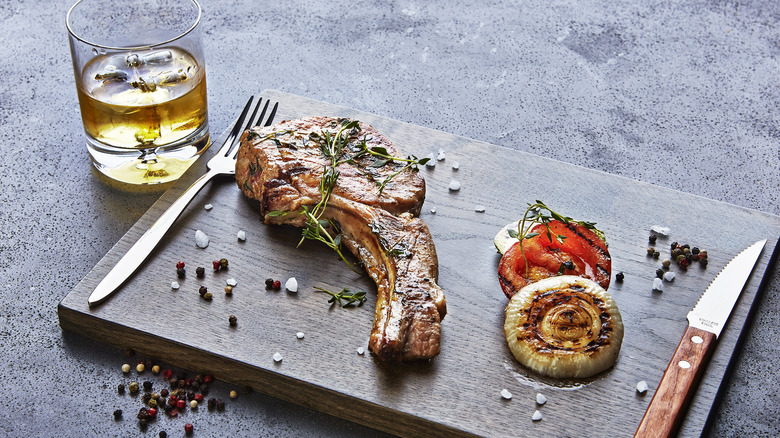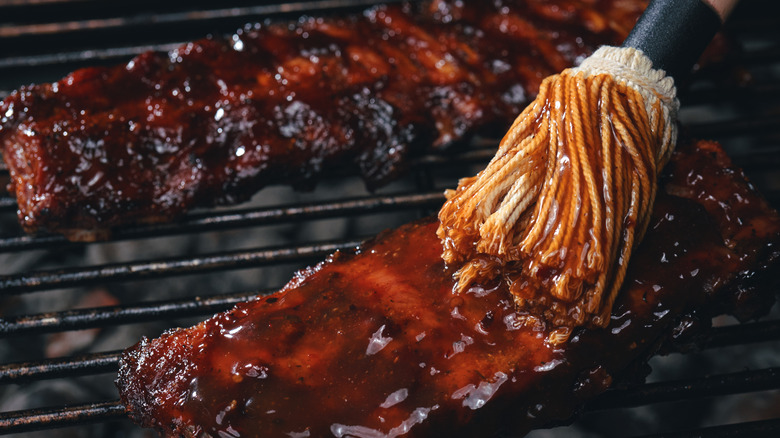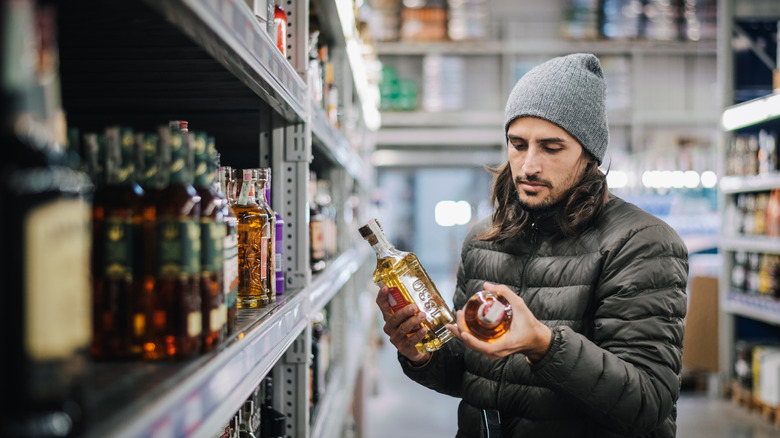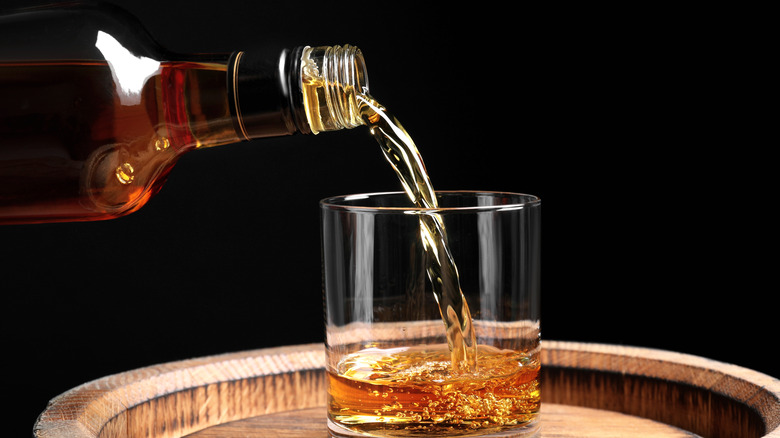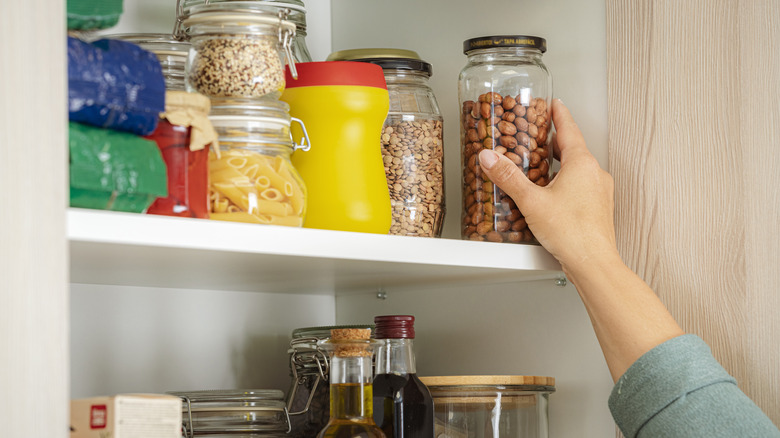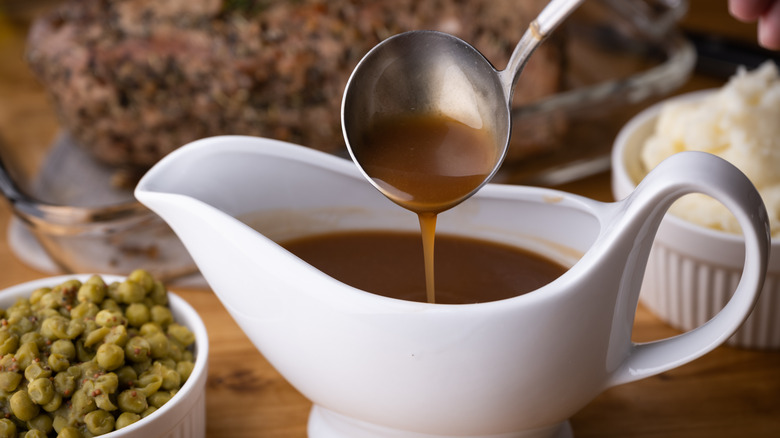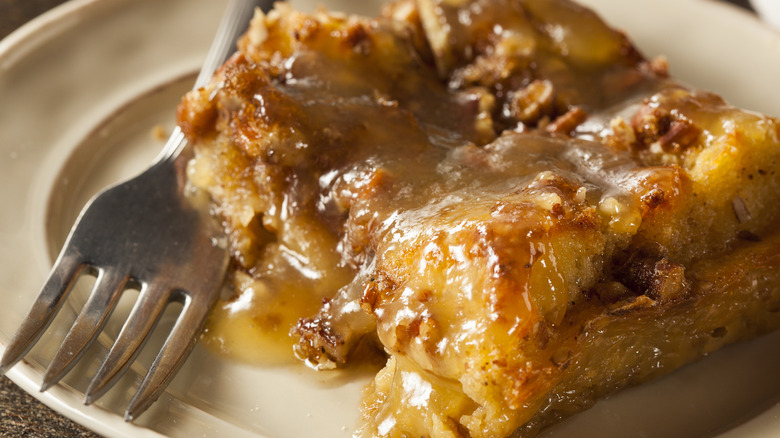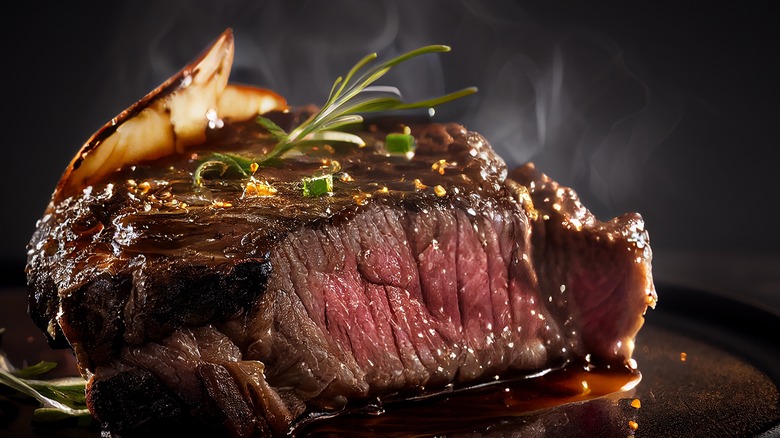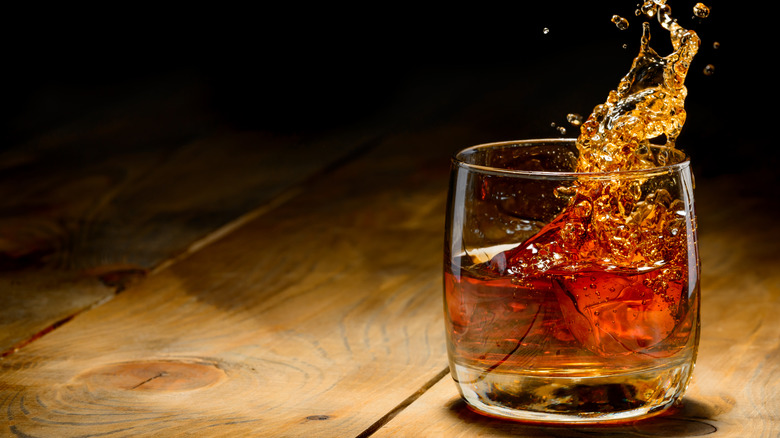8 Tips For Cooking With Bourbon, According To Kentucky Derby Chef Robert Lopez
In Louisville, Kentucky, the first Saturday in May is special. Filled with cheering, clapping, fast horses, and fabulous hats, the Kentucky Derby is also a love letter to the food and drinks of the season and the vibrant location where it's held. An event brimming with pomp and sophistication, the food and drink spread at the Derby is almost as famous as the race itself, known for elegant cocktails and iconic Southern staples. And, since Kentucky is home to many of the finest whiskey and bourbon distilleries in the United States, having a menu with a notable bourbon influence seems only fitting.
Chef Robert Lopez, head chef for the 150th Run of the Roses, created this year's menu at Churchill Downs with local ingredients and seasonality in mind, leaning on bourbon as a crucial flavor element in several of his creations. The Kentucky Derby may only come around once a year, but that doesn't mean bourbon can't be incorporated into the home chef's cooking repertoire year-round. Lopez has shared with us some of his best tips for cooking with bourbon, encouraging home chefs to use bourbon not just as a cocktail ingredient but as something to fuse into everyday recipes. From stews, sauces, and salad dressings to cakes, breads, and pies, there's no wrong way to celebrate all the flavor and nuance that bourbon has to offer.
The best bourbons for cooking are sweet and smoky
Bourbon is easy to love for many reasons, notably its expansive and versatile flavor profile. It can run the gamut, from sweeter notes like honey, vanilla, cinnamon, and caramel to more powerful flavors like smoke, wood, and pepper. These flavors, whatever they may be, make a difference when picking out a bourbon to sip on, and similarly, they make a difference when picking out a bourbon to cook with, too. According to chef Robert Lopez, as you seek out a cooking bourbon, it's best to lean into those flavors in the liquid, highlighting those sweet and smoky notes in any number of dishes.
"Bourbon adds a rich, smoky flavor to dishes, making it ideal for sauces and marinades," he said. "Use bourbon in combination with sweet ingredients like brown sugar or maple syrup, which complements its natural vanilla and caramel notes."
A favorite of chef Lopez, bourbon BBQ sauce is a great way to highlight the complex, smoky flavors of bourbon in the sauce and whatever grilled meat is lucky enough to be dipped in it. Seek out a bourbon with brown sugar or honey notes to allow this sauce to really sing.
Aim for a moderately priced bourbon
If your favorite whiskey is $20 or less, you understand that price only sometimes correlates to quality. It's easy to believe that the higher the price tag, the higher the quality, but it's not always the case. When deciding on a bourbon to cook with, it's essential to not immediately reach for the most expensive bottle on the shelf.
A limited-release or single-cask bourbon is nice on your home bar and for sipping alongside a steak dinner, but it may impart too much into the dish itself. Paying attention to that price tag goes both ways; the cheapest bottle won't do you any favors, either.
For chef Lopez, mid-range is the sweet spot, offering the ideal balance of flavor and cost while enhancing the rest of the dish's ingredients. "Quality does matter with bourbons," said Lopez. "I try to avoid using the cheapest options as they can be harsh and less nuanced, which might detract from the overall flavor of your culinary creations."
To find a mid-shelf bourbon that falls into this sweet spot, focus on the $20 to $50 range, where you'll find various quality options. Evan Williams Bottled-in-Bond is a balanced bourbon with sweet, toasty notes, and for $20, it is an excellent choice for use in a demi-glace or gravy. For something with a bit more fruit and spice, Maker's Mark 46 starts at $30 and can lend the right richness and spice to chocolate truffles or pecan pie.
Cooking with high-proof vs. low-proof bourbons
Have you ever taken a sip of whiskey and been positively blown away by a powerful wave of alcohol? That intensity results from the proof or the amount of alcohol in the bottle. That strength can be a deciding factor when seeking out whiskey to drink, and similarly, proof is a crucial element when seeking out whiskey for cooking.
Bourbon production comes with a fair amount of rules. As such, there is a minimum proof requirement: Bourbon must be bottled at a minimum of 80 proof or 40% alcohol by volume. Lower-proof bourbons are a great place to start for a bourbon beginner, as they tend to be milder and sweeter than the higher-proof options.
For chef Robert Lopez, proof makes all the difference when deciding on a bourbon in the kitchen. Whereas a high-proof bourbon lends more intense flavors for a concentrated, reduced sauce or in a flambé (think Bananas Foster), a low-proof bourbon is less aggressive, making it a useful ingredient for something more delicate, like a spicy honey-glazed salmon.
Pantry staples and seasonal flavors are bourbon's best friends
Looking to the seasons is always a valuable step when planning a recipe, and if you plan to make bourbon a key ingredient in a dish, chef Robert Lopez recommends looking no further than your calendar. "When preparing bourbon-inspired recipes, home chefs should look for seasonal ingredients that complement the rich, warm notes of bourbon," he said.
The colder months of the year are almost too perfect for getting bourbon inspiration; a warm apple pie, rich with notes of cinnamon and caramel, can be complemented by the toasty flavor of bourbon. In winter, when we crave something bright and uplifting to get us through the cold, a bourbon-infused sauce can be enhanced with seasonal ingredients like oranges and cranberries, notes Lopez, adding depth of flavor and an acidic burst.
In addition to shopping for seasonally-inspired, chef Lopez recommends shopping with your pantry in mind. Lopez identifies key staples to keep on hand, like maple syrup, molasses, Dijon mustard, and apple cider vinegar, all of which pair well with the woody, sweet bourbon undertones. Additionally, having a selection of fresh herbs, such as thyme or rosemary, can add earthiness to a bourbon-inspired slow-roasted prime rib or an old-fashioned beef stew.
Incorporate bourbon into a savory sauce
While many red meat eaters rely on robust red wine to accompany their marbled ribeyes and roasted prime ribs, bourbon is another equally delicious option to complement a hearty meal. Bourbon's oaked, woody notes are perfect accompaniments, working well as an ingredient that matches savory flavors in sauces, gravies, and glazes.
For chef Robert Lopez, using bourbon as a sauce component is a no-brainer; as an ingredient, it adds a complex layer of flavors, so long as you know how to use it. For the technique, keep in mind that adding straight, uncooked bourbon to a sauce will make the consistency thinner, while reducing the bourbon before you combine it with other ingredients will thicken things up.
If you want a more prominent whiskey flavor, then a splash of unreduced bourbon will be your best bet; if you're okay with subtler notes in exchange for higher viscosity, be aware that many of the strong nuances will cook out of your sauce. Lopez recommends using bourbon in a dish like baked ham. The base of the sauce adds sweetness to contrast the salty, fatty meat, but adding bourbon to the brown sugar glaze can provide impactful maple and caramel notes while also helping to create a crispy, crackly texture on the outside.
Bourbon can sweeten up your favorite desserts
Just as a sweet and smoky bourbon can enhance any number of savory dishes, it has the same ability in some of your favorite desserts. Consider the tasting notes: vanilla, caramel, and toffee are the flavors in some of the most delicious desserts, and you can find those same flavors in any number of quality mid-shelf bourbons. Furthermore, bourbon can substitute for certain baking ingredients, like vanilla extract, to achieve the same aroma with a deeper, more complex flavor.
A favorite of chef Lopez, a bourbon bread pudding is enhanced by those sweet, warming notes in the bourbon, adding sophistication to a relatively simple dish. In addition to flavor, infusing bourbon into a cake can provide extra moisture and richness when used in a simple syrup or a sweet bourbon glaze drizzled on top. Rather than settle for a standard banana bread, take Lopez's advice and use bourbon to complement the sweet bananas. In contrast, avoid using bourbon in a spicy or highly acidic dessert, like a spicy chocolate cake or a Key lime pie.
Be warned: baking with bourbon requires attention to detail. According to Lopez, using bourbon in cakes or bread can impact baking times since more liquid is added to the batter. Additionally, alcohol can change the structure and strength of a cake, potentially making it denser. You can add water to compensate for the difference in volume and ensure you still have a light cake with a good crumb.
Prepare an entire steak dinner using bourbon
Bourbon and meat lovers rejoice: You can prepare an entire steak recipe from start to finish, using bourbon as an ingredient in every element. According to chef Robert Lopez, you should start with the marinade. "Mix the bourbon with ingredients like soy sauce, garlic, and brown sugar to tenderize the steak and infuse it with flavor," says Lopez. Let the steak bathe in this flavorful marinade for a while; we recommend at least 20 minutes of marinating time but no more than a few hours.
You've allowed your steak time to marinade; now it's time to take it to the fire. "After searing the steak, deglaze the pan with bourbon, add beef broth and seasonings, and let it simmer until thickened for a rich, flavorful sauce," says Lopez. Reserve that bourbon reduction; you'll want it later to dip your steak in and drizzle over a side of crispy roasted potatoes. Finally, as your steak is almost done, Lopez recommends brushing the steak with a bourbon glaze, adding a caramelized, smoky finish to enhance the meat's natural flavors.
Mistakes to avoid when cooking with bourbon
Cooking with alcohol, any alcohol, can be tricky. If you do it right, the final product can be truly glorious. If you fall for any of the common mistakes or misconceptions, you may end up with something utterly tragic. The first thing to avoid? Using too much of it. According to chef Robert Lopez, moderation is key: while that strong flavor can occasionally be helpful depending on the application, it can also be overwhelming if you opt for an over-the-top pour.
Additionally, Lopez notes that just because you're cooking or baking with bourbon doesn't mean all the alcohol will burn off, leaving your dish booze-free. The opposite is true: depending on the cooking time or method, some of that alcohol will remain, so be mindful of exactly who is getting to partake in your bourbon-infused meal.
Lopez says another mistake to avoid, especially when using bourbon in a hot dish, is not being mindful of the heating element. While adding bourbon to your hot, bubbling pan sauce will surely add flavor, its high alcohol content can also catch fire unexpectedly. Unless you're planning on using bourbon in a flambé, add it to the pan slowly to give the alcohol time to evaporate before adding in more.
